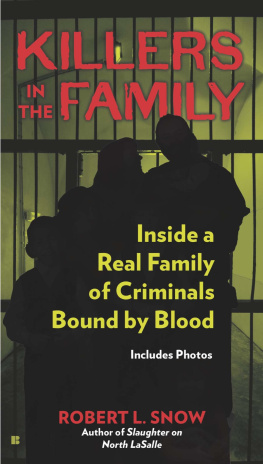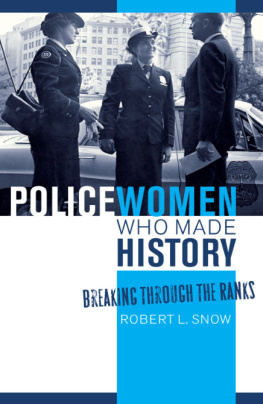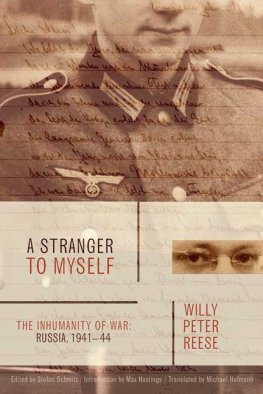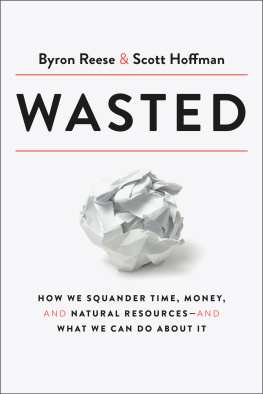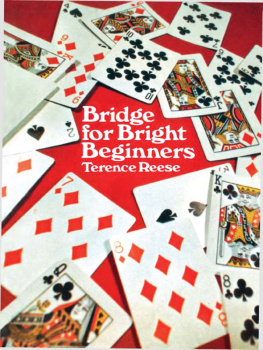Berkley titles by Robert L. Snow
SLAUGHTER ON NORTH LASALLE
KILLERS IN THE FAMILY
THE BERKLEY PUBLISHING GROUP
Published by the Penguin Group
Penguin Group (USA) LLC
375 Hudson Street, New York, New York 10014

USA Canada UK Ireland Australia New Zealand India South Africa China
penguin.com
A Penguin Random House Company
KILLERS IN THE FAMILY
A Berkley Book / published by arrangement with the author
Copyright 2014 by Robert L. Snow.
Photos from the Indianapolis Star March 17 1986 McClatchy. All rights reserved. Used by permission and protected by the Copyright Laws of the United States. The printing, copying, redistribution or retransmission of this Content without express written permission is prohibited. Website: indystar.com.
Penguin supports copyright. Copyright fuels creativity, encourages diverse voices, promotes free speech, and creates a vibrant culture. Thank you for buying an authorized edition of this book and for complying with copyright laws by not reproducing, scanning, or distributing any part of it in any form without permission. You are supporting writers and allowing Penguin to continue to publish books for every reader.
BERKLEY is a registered trademark of Penguin Group (USA) LLC.
The B design is a trademark of Penguin Group (USA) LLC.
For information, address: The Berkley Publishing Group,
a division of Penguin Group (USA) LLC,
375 Hudson Street, New York, New York 10014.
eBook ISBN: 978-1-101-61515-7
PUBLISHING HISTORY
Berkley premium edition / July 2014
Cover design by Jane Hammer.
Cover art: Girl Behind Bars Matej Hudovernik/Shutterstock;
Portrait of Large Family RimDream/Shutterstock.
Most Berkley Books are available at special quantity discounts for bulk purchases for sales, promotions, premiums, fund-raising, or educational use. Special books, or book excerpts, can also be created to fit specific needs. For details, write: Special.Markets@us.penguingroup.com.
Version_1
For Joy and Julian Bertram
and James and Luke Mullett
with love
FOREWORD
H is dream had finally come true.
At a little before 9:00 A . M . on June 18, 2012, retired detective sergeant Roy West sat outside of Criminal Court 2 in downtown Indianapolis. The dream hed had for more than twenty-six yearsof finally seeing justice for thirteen-year-old Dawn Marie Stuardwas at last coming true. West looked down at the thick folder he held in his lap. Dawns case had never left his thoughts for the last twenty-six years, and he had never given up hope that this day might finally come. Even after retiring from the Indianapolis Police Department five years earlier, West had kept the file and looked through it frequently. Then, when he began working as an investigator for the Marion County Prosecutors Office, he had continued to revisit the case over and over in the hope that something new would pop up. West would reread the interviews and notes from his investigation, thinking back over the years and wondering what he might have missed. He had talked with prosecutors a number of times over the years, asking what they felt the case needed in order to make it viable for prosecution. West had had a long career with many successes, but this particular case still haunted him.
West had served on the Indianapolis Police Department for more than thirty-five years. Hed joined in 1972 and had held various positions within the department until he transferred to the Homicide Branch in 1986, where hed found his niche and served until his retirement in 2007. Although West was much too modest a man to ever believe it, he became something of a legend during his time as a homicide investigator, not only for solving many, many murder cases, but even more notably, for solving a number of cases that other homicide detectives had labeled unsolvable. He had even closed the North LaSalle Street murder case, unquestionably the most infamous murder case in Indianapolis history, which had lain unsolved for thirty years before West began looking into it.
But even with all of his successes, the one case he couldnt solve but had never given up on had been the Dawn Marie Stuard murder case. It had been his first case as a homicide investigator. More important, though, to West, it had been a case that involved a totally innocent thirteen-year-old girl. West could never get that out of his mind. A young child just starting out in life had been brutally murdered, and even though West knew without a doubt who had committed the murder, he had never been able to gather the evidence necessary to bring the case to trial.
For the tenth time, West looked down at his watch. The jury selection would be starting soon. The former detective couldnt help but be excited that modern science had finally done what he had been unable to do in 1986. Modern science had produced the evidence that West had searched for for over a quarter of a century. Still, along with the excitement, West could also feel his stomach roll with uncertainty. He had taken part in dozens and dozens of jury trials during his career and knew that the outcome of a jury trial was never certain. Would the new evidence be enough? Would it convince the jury to convict Dawn Marie Stuards murderer?
After a moment, West pushed his worries aside, since there was nothing he could do about them, and began reviewing his notes on the case again. He didnt want to look confused or uncertain when he testified. Thumbing through the folder, West went back to 1986.
ONE
T hirteen-year-old Dawn Marie Stuard disappeared on March 16, 1986.
At the time, the Stuard family lived in the 1600 block of North Dequincy Street on the east side of Indianapolis, Indiana, but Dawns father, Ted Stuard, had been working at a propane company in Ohio and was researching the possibility of purchasing Apollo Propane in Dayton. Before he and his wife, Sandy, could manage the purchase, though, they needed to be certain that they would have enough contracts in place to assure the business would prosper, so Ted and Sandy would drive to Ohio during the week, leaving their daughter, Dawn, in Indianapolis with an aunt, then come home every weekend. It was a bit stressful on the family, but Ted hoped it was just a short-term necessity.
It was just a temporary thing, Ted said. We didnt want to have to take Dawn out of school until we were absolutely sure about moving permanently to Ohio.
More than anything, Teds dream was to give his family a financially secure future. Once he and his wife owned the propane company, then this could all come true. They would make much more money and be able to provide a higher quality of life for their family. There would be no more traveling back and forth to Ohio every week. There would be no more evenings apart. There would be no more of these long drives and of living at a motel. Although Dawn would have to change schools, they knew she was a very sociable little girl who made friends easily. They felt certain she would make the transition smoothly. Ted and Sandy both looked eagerly toward the point when their family would be together all of the time. Yes, things were soon going to be great for the Stuard family.

